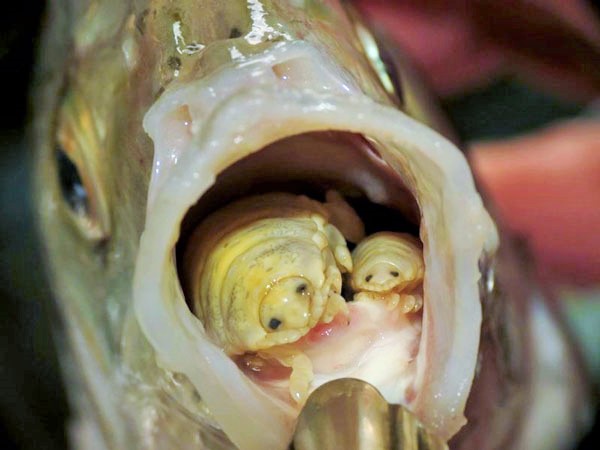Isopod Facts, Tongue-Eating Louse
A-Z Collection of Cool Animals Challenge
I is for Isopod Facts
Today I bring you the following isopod facts for your, uh, enjoyment. Eww? What a bizarre creature!
The tongue-eating louse, or Isopod, is a strange white parasitic crustacean of the Cymothoidae family, best known for eating a host fish’s tongue, and then replacing it with itself, acting like a new tongue.
Eww!

Isopod Facts
- The tongue-eating louse enters the fish through the gills.
- After attaching itself to the fish’s tongue, the parasite feeds on the tongue’s blood, extracting it with its front claws. This causes the fish’s tongue to atrophy from lack of blood.
- The isopod then attaches itself to the stub of what remains of the tongue, and then becomes the fish’s new tongue.
- If that isn’t strange enough, the fish will then go on doing what it’s always done — living an apparently normal life, using the louse just like a normal tongue, and grinding food against its teeth on the roof of the mouth.
- Once the tongue is replaced, the louse will feed on the host’s blood or mucus. Other than replacing the fish’s tongue, it doesn’t appear that any other damage is caused to the host.
- The tongue-eating louse is currently the only known parasite to replace a host’s organ in its entirety with itself.
Isopod Facts
- The tongue-eating louse is commonly found from the Gulf of California south to north of the Gulf of Guayaquil, Ecuador. It has been recorded in waters ranging from 6 ft 7 in (2 meters) to almost 200 ft (60 m) deep.
- Female Isopods range from 0.3–1.1 inches (8-29 mm) long and 0.16–0.55 inches (4–14 mm) wide.
- The males measure 0.3–0.6 inches (7.5–15 mm) long and 0.12–0.28 inches (3–7 mm) wide.
It is believed that this strange little creature is not harmful or poisonous to humans, although the louse can bite if picked up alive.
Sources for Isopod Facts: Wiki
Images: RachaelB
Video: Animal Wire
***
I is for Isopod Facts – Tongue-Eating Louse, A-Z Collection of Animals Share on X
***
I hope you have enjoyed, “ I is for Isopod Facts, the Tongue-Eating Louse”
![]()
A QUESTION FOR YOU: What do you think of the ISOPOD – Tongue-eating louse? Ewww?
*** Please leave a comment below and remember to share. ***
It’s just sexy!

As always, thank you for taking the time to visit my blog.
♥ PEACE ♥
*
Disclosure: Animal Bliss is an All FUR One affiliate and will earn a (very small) commission from purchases made through links on this website.
(Coffee money – thank you!)
😀
- Mindful Travel With Your Dog This Holiday Season - December 23, 2019
- A-Z of Australia’s Endangered Wildlife - December 20, 2019
- Teaching Your Kids How to Walk the Dog Safely - December 2, 2019

These are so cool! Kinda of freaky looking, but very fascinating. I’ve never seen anything like it, but am always surprised by all nature has to offer!
They pretty wild, aren’t they, Jessica? Freaky looking indeed. I sure wouldn’t want them in my mouth. Nature sure is grand. Hey, thanks so much for stopping by! I do appreciate your visit and hope you’ll come back soon. 🙂
Omg. Wow. Thats so freaky. Wow. Love all the interesting animal facts and wow some cool and yucky ones. Lol love the site
Hey, Kim! Nice to see you here on my blog! I’m glad you’re enjoying it! Come back again and again! 🙂
Wow! I’ve seen these images and thought they were photoshopped; I had no idea that this was real. This is such a cool factoid. Thanks!
Yep, these are definitely real. Aren’t they the coolest? Unless you step on one maybe. Then they not be so much fun. lol Take care, Kimberly!
Oh wow… just learnt something new and it’s kind of creepy. Great post.
Yes, it is creepy. I have to agree with you there. lol Thank you for checking out my post, TF! I’m off to go read your post now — I is for Instincts. Ciao for now! 🙂
What a complete post! Wow that is one creepy creature, so glad I am not a fish!
#Blogging from A-Z 2015 this year two themes Movies and What’s in a name
4covert2overt ~ A PLACE IN THE SPOTLIGHT http://4covert2overt.blogspot.com/
DEFINING WAYS http://mariacatalinaegan.com/
⋱ ⋮ ⋰.,;***;,.⋱ ⋮ ⋰
⋯¤♥¤⋯.(^_^)⋯¤♥¤⋯
⋰ ⋮ ⋱…_/l\_…⋰ ⋮ ⋱
♫ ƤҼƌҪҼ ƌƝƊ ĻƠṼҼ ॐ βԼƐֆֆїɳɠֆ ƌƝƊ βԼїֆֆ ♫
Thank you for your visit, Catalina! Creepy, yes! I’m glad I’m not a fish either. Take care, and have fun with the A-Z Challenge! 🙂
Now that was a cool video!. Disgusting. But very cool.
Stopping in from A to Z and thanks for the continued participation!
Stephen Tremp
A to Z Co-host
Twitter: @StephenTremp
Disgusting is right! Eww. Thanks from visiting, Stephen! Going to stop by your blog now! See ya there!